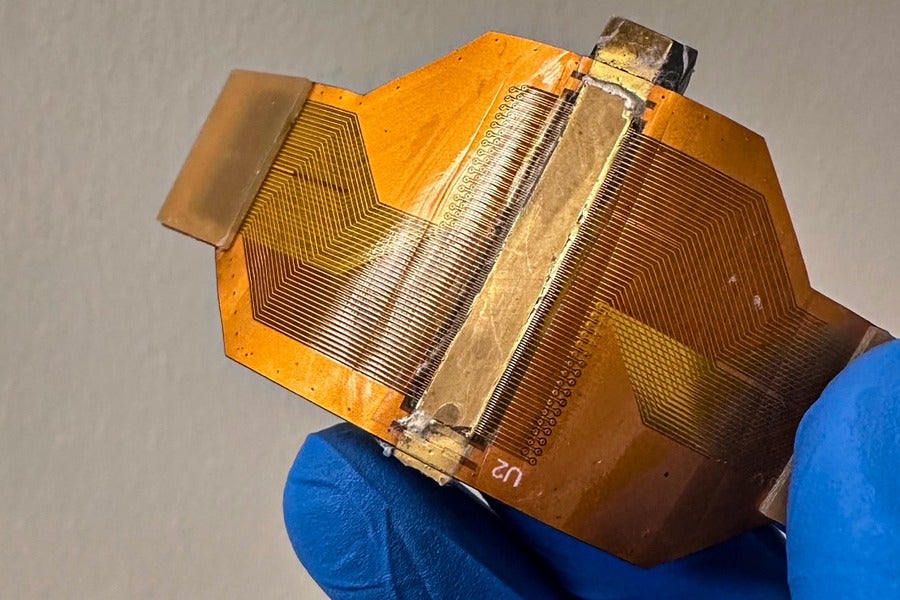
Researchers at the Massachusetts Institute of Technology (MIT) have developed a small ultrasound sticker that can monitor the stiffness of organs deep inside the body.
The sticker, designed to be in size of a postage stamp, can be worn on the skin to detect the signs of disease, such as liver and kidney failure and the progression of solid tumors.
In a study published in open access journal Science Advances, the sensor is designed to transmit sound waves through the skin and into the body.
The sticker will measure and track the patterns of the sound waves that reflect from the internal organs, which can be read as a signature of organ rigidity.
The sticker can continuously monitor the stiffness of organs over 48 hours and detect the slightest changes that could signal the progression of the disease.
In the preliminary studies, the researchers found that the sensor can detect early signs of acute liver failure in rats and are working to adapt the design for use in humans.
The researchers intend the sticker could be used in intensive care units (ICUs), where the low-profile sensors could continuously monitor patients who are recovering from organ transplants.
MIT professor of mechanical engineering and senior author of the paper Xuanhe Zhao said: “When some organs undergo disease, they can stiffen over time.
“With this wearable sticker, we can continuously monitor changes in rigidity over a long period, which is crucially important for early diagnosis of internal organ failure.”
“We used advanced fabrication techniques to cut small transducers from high-quality piezoelectric materials that allowed us to design miniaturized ultrasound stickers.”
Hsiao-Chuan Liu, a visiting scientist at MIT at the time of the study and currently an assistant professor at the University of Southern California (USC), was the lead author of the paper.
The co-authors of the paper include Xiaoyu Chen and Chonghe Wang, with collaborators at USC.
Hsiao-Chuan Liu said: “We imagine that, just after a liver or kidney transplant, we could adhere this sticker to a patient and observe how the rigidity of the organ changes over days.
“If there is any early diagnosis of acute liver failure, doctors can immediately take action instead of waiting until the condition becomes severe.”
According to the publication, the tissues and organs in the human body will stiffen with age, and certain diseases may result in elevated levels of stiffening, signalling potential decline in health.
Currently, clinicians measure the stiffness of organs such as the kidneys and liver using ultrasound elastography, a technique that resembles ultrasound imaging.
Ultrasound elastography is normally used in the ICU to monitor patients who have recently undergone an organ transplant.
The researchers aim to provide a more continuous, wearable alternative solution, which builds on an ultrasound sticker previously developed to image deep tissues and organs.
They intend to miniaturise the ultrasound elastography to fit on a stamp-sized sticker, while retaining the same sensitivity of commercial hand-held probes.
The commercial probes incorporate about 128 piezoelectric transducers, each of which transforms an incoming electric field into outgoing sound waves.
The researchers accurately fabricated 128 miniature transducers that they incorporated onto a 25mm2 chip and lined the chip’s underside with an adhesive made from hydrogel.
Hydrogel is a sticky and stretchy material that contains water and polymer and allows sound waves to travel into and out of the device almost without loss.
Also, the researchers are planning to pack the sticker into a more portable, self-enclosed version, where all electronics and processing are miniaturised to fit into a slightly larger patch.
It enables the sticker to be worn at home, to continuously monitor conditions over longer periods, such as the progression of solid tumours, which are known to harden with severity.
Research paper senior author, USC professor Qifa Zhou said: “After organ transplantation, the first 72 hours is most crucial in the ICU. With traditional ultrasound, you need to hold a probe to the body.
“But you can’t do this continuously over the long term. Doctors might miss a crucial moment and realise too late that the organ is failing.
“Our imaging sticker picked up on longitudinal waves, whereas this time we wanted to pick up shear waves, which will tell you the rigidity of the organ.”


